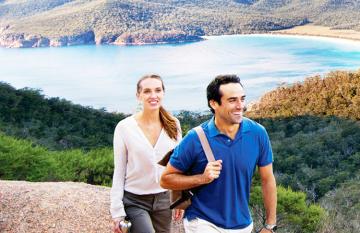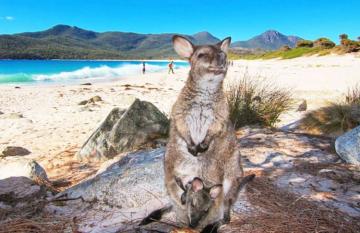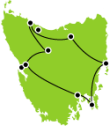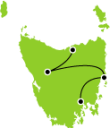
Despite the dubious reputation of Tasmanian salmon, the island state’s pristine waters still play home to some beautiful local fisheries, as well as fantastic small-scale fishers pushing local seafood in the right direction. Here is everything you need to know about Tasmanian salmon, and where to find the best Tasmanian salmon substitutes around Tassie.
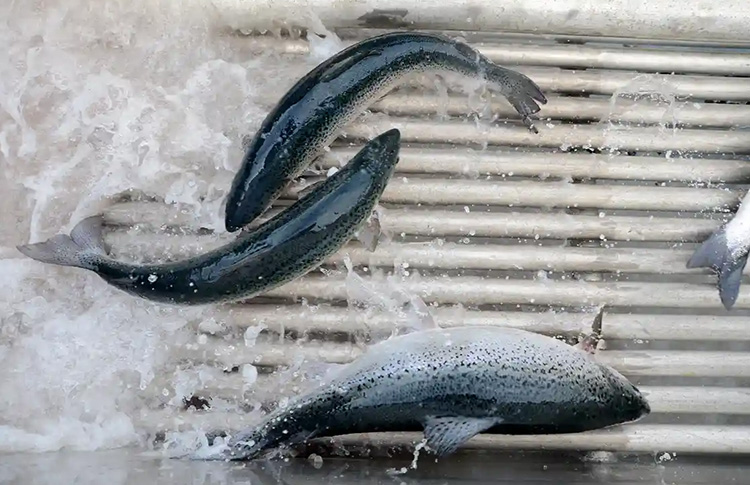
Contents
Tasmanian salmon: what went wrong
Tasmanian Salmon is a big global brand – but it wasn’t always that way. Essentially all Tasmanian salmon is farmed in ocean cages, and the vast majority of Tasmanian salmon is Atlantic salmon. Unsurprisingly, given its name, Atlantic salmon is not native to Tasmania (in fact, it’s not naturally found anywhere beyond the chilly waters of the North Atlantic, in a region stretching between North America and Northern Europe).
This species was initially introduced to Australia in the mid-1800s, as fertilised eggs from the UK, in the hope of establishing wild sea-run populations. Which never really took off. The practice of growing these species in enclosed cages and pens, however, was introduced to Tasmania about a century later, in 1986. With much greater success.
Along the way, people became greedy, and things got dirty.
In the late 1980s, only a handful of boutique operations were farming Atlantic Tasmanian salmon as an experimental project. On the back of profitable early results – not to mention strong government support and a massive marketing operation, farming has expanded relentlessly, booming into an almost $1billion-a-year industry by 2020. This growth has been backed by multinational companies promoting the island state’s clean, green image.
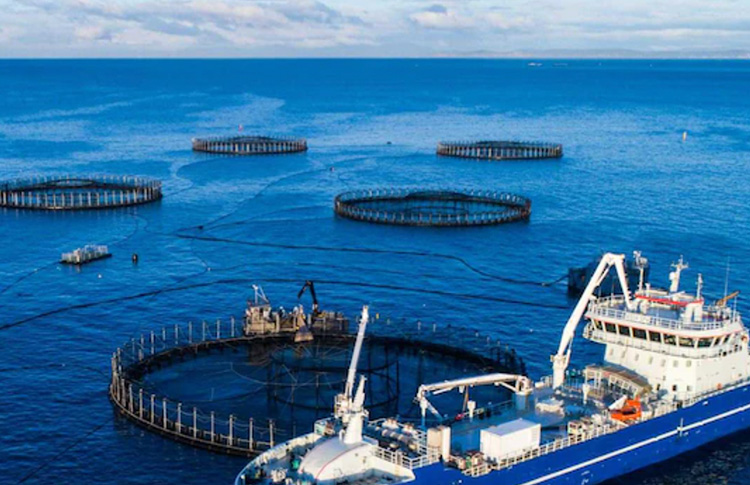
Environmental Impact
Most Tasmanian salmon farms operate in shallow inshore waters – such as Macquarie Harbour – and they have increased both in number and concentration over the years. Such areas have also recorded increasingly alarming levels of bacteria and toxins in the water, resulting from the build-up of effluent underneath fish farm pens, wherein huge schools of fish are crammed into a relatively small space.
Increased nitrogen levels in the water, has led to damaging algal blooms and the disappearance of many local marine species such as leatherjacket, abalone, and kelp. The nutritional quality of the fish has suffered significantly, too, with reputed lower levels of omega-3 and high-quality protein over the years.
There have even been scientific reports linking salmon farming to an increase of mercury in the salmon itself, as well as the appearance of several neurotoxins in local waterways and water supply chains.
But don’t worry – it doesn’t have to be all bad news!
How the Tasmanian salmon industry can improve
Despite all this, Tasmanian salmon farming still has a bright, or at least big, future. Plans to expand the industry even further have been put forward by government and companies. The best way to achieve this future bsome experts say, is to transition towards getting these toxic, intensive salmon farms out of the pristine waters and having closed-loop salmon farms on land.
This solution isn’t perfect. But such operations would go a long way towards eliminating the devastating impacts of Tasmanian salmon farms on local waterways and the local community. Instead, the suitable climate and high local water quality that helped Tasmanian salmon receive its world-renowned reputation could still be put to good use in creating a premium, sustainable local product.
Support ‘good’ Tasmanian salmon
At the moment, it’s difficult – if not impossible – to find any Tasmanian salmon that isn’t farmed in such destructive and unhealthy conditions. The transition to on-land Tasmanian salmon farming will be gradual. However, you can make a statement of support towards cleaning up the industry by making one simple choice: reach for the other kinds of local fish that are just as good as – and currently much better for everybody than – Tasmanian salmon!
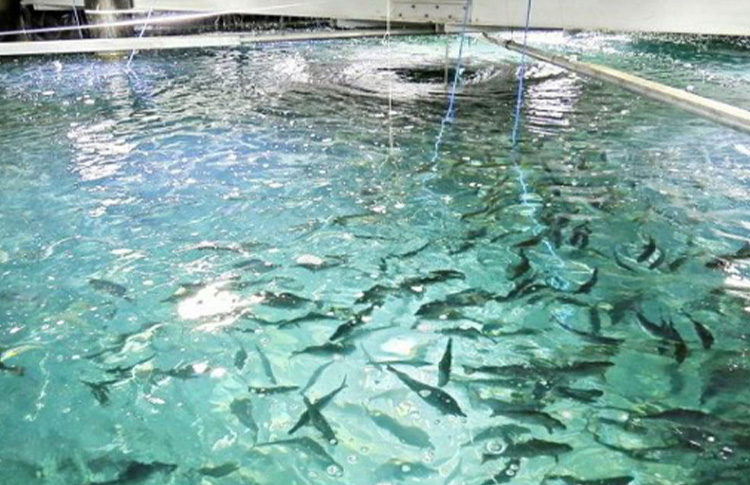
The best Tasmanian salmon substitutes to eat:
Tasmanian salmon is a popular ingredient in many recipes and on many restaurant menus. However, if you want to make a better choice when dining out on your Tasmanian road trip, or while heading to a local fish or farmers market and cooking up a storm at your holiday-home hideaway, then support a better version of the Tasmanian salmon industry by reaching for one of these tasty alternatives:
Leatherjacket
A beloved local favourite for recreational fishers, leatherjacket is often best when simply pan fried in butter. However, keep an eye out for local restaurants and chefs offering other delicious incarnations: whether grilled whole over coals, or added to spicy Asian curries and hearty soups or stews (for which their firm flesh holds up well).
Snapper
This is technically not a traditional local species, with snapper only moving further south from warmer climes in recent years, with the rising sea temperatures. However, now that stocks are arriving and thriving in good numbers in certain local fisheries, red snapper are becoming a tasty addition to local, wild-caught Tasmanian seafood menus. Fresh snapper sliced raw as sashimi is an enticing option!
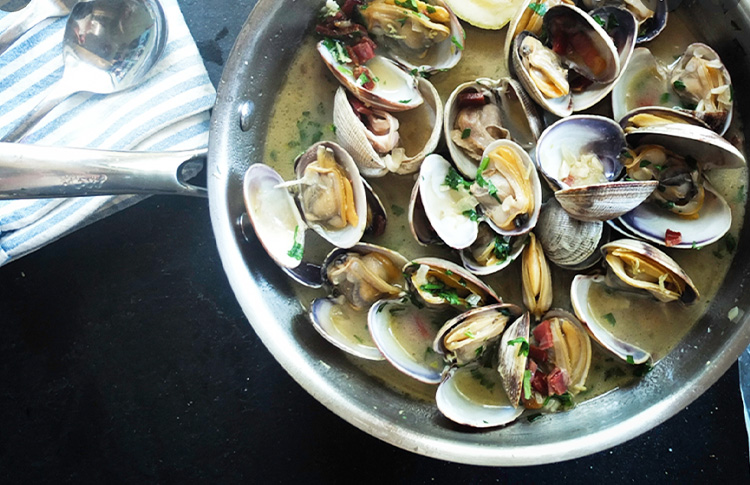
Flathead
Probably the most iconic local fish species, sand flathead are by far the most common species caught by recreational fishers in Tasmania (where these bottom-dwelling fish naturally thrive in big numbers, close to shore). It is a mild, slightly sweet fish, which is delicious simply pan fried or grilled with the skin on. It’s firm, fatty, scalloped flesh also makes it great for steaming and poaching.
Australian Mackerel:
A small, schooling fish species, common jack mackerel have historically been used primarily for bait and fish meal. However, more and more people are discovering the joys of eating these tasty, highly nutritious, highly sustainable species, too. Simply grilled whole, over the barbecue, served with a squeeze of lemon and eaten whole is hard to beat!
Blue eye trevalla:
A beautiful cooking fish, blue eye trevalla is the gem of many a Tasmanian seafood restaurant menu. They are big, thick-bodied fish who thrive in sub-Antarctic and southern waters all year round in healthy numbers, making them very popular for commercial fishers (despite some by-catch issues). The flesh is firm, keeping its shape well whether being baked, fried, grilled or barbecued, and its mild, delicate taste combines well with other strong flavours, making it a common crowd-pleaser.
If you’re visiting Tasmania and keen to try one of these local varieties, you can find specific spots to pick up delicious local seafood in FLT’s seafood guide to Tasmania and guide to local Tasmanian beer, as well as articles outlining recommended restaurants and eateries to visit in both Hobart and Launceston.
Take a look at FLT’s dedicated Tasmania travel page, which offers some pre-arranged self-drive itineraries as well as the option to speak directly with local FLT travel experts, who can help you plan your own customised Tasmanian itinerary.
Recent Posts
Blog Categories
Blog archives
- April 2024 (1)
- March 2024 (13)
- February 2024 (3)
- January 2024 (5)
- December 2023 (6)
- November 2023 (4)
- October 2023 (11)
- September 2023 (2)
- August 2023 (6)
- July 2023 (2)
- June 2023 (17)
- May 2023 (3)
- April 2023 (5)
- March 2023 (8)
- February 2023 (9)
- January 2023 (12)
- December 2022 (9)
- November 2022 (12)
- October 2022 (12)
- September 2022 (12)
- August 2022 (6)
- July 2022 (9)
- June 2022 (7)
- May 2022 (3)
- April 2022 (4)
- March 2022 (6)
- February 2022 (1)
- January 2022 (4)
- December 2021 (2)
- November 2021 (3)
- October 2021 (1)
- September 2021 (4)
- August 2021 (10)
- July 2021 (13)
- June 2021 (6)
- April 2021 (2)
- March 2021 (2)
- February 2021 (1)
- January 2021 (1)
- December 2020 (2)
- November 2020 (3)
- October 2020 (2)
- September 2020 (1)
- August 2020 (1)
- July 2020 (1)
- June 2020 (1)
- May 2020 (1)
- April 2020 (1)
- March 2020 (1)
- February 2020 (2)
- January 2020 (4)
- December 2019 (2)
- November 2019 (1)
- October 2019 (1)
- September 2019 (5)
- August 2019 (1)
- July 2019 (5)
- June 2019 (1)
- May 2019 (1)
- April 2019 (1)
- March 2019 (1)
- February 2019 (1)
- January 2019 (1)
- December 2018 (1)
- October 2018 (1)
- May 2018 (1)
- February 2018 (1)
- December 2017 (1)
- October 2017 (1)
- June 2017 (1)
- May 2017 (1)
- February 2017 (1)
- January 2017 (1)
- September 2016 (1)
- August 2016 (2)
- July 2016 (1)
- June 2016 (1)
- May 2016 (1)
- April 2016 (1)
- December 2015 (1)




